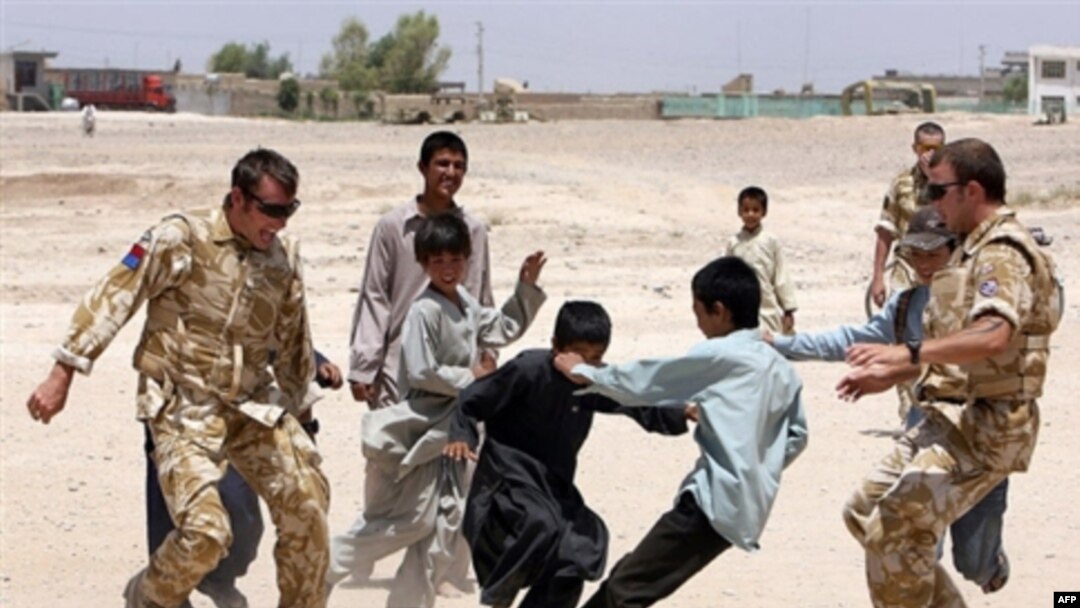But Helmand is also home to Taliban militants, opium production, and tribal tensions.
Taliban fighters' brazen takeover of a town in southern Afghanistan this month marked a major setback for NATO and its Afghan allies. Just days before that seizure, British officers were touting the power-sharing deal that kept Taliban fighters out the town of Musa Qala as a possible blueprint for other parts of Helmand Province.
These problems are hampering NATO's British-led efforts to rebuild the province.
Improving Lives
Winning Afghan "hearts and minds" is the overriding ambition of nearly every NATO official or soldier here. Military and other officials acknowledge that the Taliban-led insurgency cannot be defeated without improving the lives of ordinary Afghans.
But they also express a frustrating sense that locals are simply willing to side with whichever side offers better terms.
The provincial reconstruction team (PRT) in Helmand's Lashkar Gah is part of NATO's effort to win public trust.
Tens of millions of dollars are pouring into the province. Much of that money is provided by Britain, but junior partners Denmark and Estonia play a part in Lashkar Gah, too.
"Those projects vary enormously, but there are small infrastructure-type projects, such as providing covered stalls at the Friday market, and some work to prevent [the Helmand River] from eroding the bridge, the Bolan bridge, and also rehabilitating some of the police checkpoints, and that sort of thing," says British diplomat Fergus Cochrane-Dyet, acting head of the Helmand PRT. "But also we've worked with a women's center in that regard. I think we've done a children's play area."
A NATO source says the market and the bridge were not necessarily among NATO's top priorities, but they were essential to securing the good will of the provincial leadership.
Cochrane-Dyet says Britain is investing $38 million into longer-term projects, mostly focused on rural infrastructure. He says the money will translate into 1,000 wells and 49 kilometers of roads that are crucial for local economic development.
A recurring theme at NATO briefings is the contribution that roads can make to opening markets for alternatives to Helmand's opium poppies -- the source of more than half of Europe's heroin.
Promoting The Kabul Government
Ian Huntley, deputy commander of the military component of the PRT in Lashkar Gah, stresses that NATO wants its aid to be regarded as an Afghan achievement -- for a variety of reasons.
"The other point about it is, of course, that we're trying to win hearts and minds not for ourselves, but for the Afghan government," Huntley says. "So the fact that there's a Union Jack on something wouldn't help; [it] would probably just make something a target...associated with outsiders, with foreigners. But what you want is for the locals to see that their standard of living is going up and [to] associate that with the government of Afghanistan -- not with outsiders."
NATO officials say they try to hire local contractors for their projects. In Lashkar Gah, the PRT has distributed nearly $3 million in cash to Afghan contractors in since July.
The Security Problem
But security remains a major obstacle. For example, Estonia is providing equipment to a local hospital, in that country's first-ever development-aid experience.
The city of Lashkar Gah provides the backdrop for that Baltic state's first-ever experience providing development aid.
"Estonia has decided to spend $125,000 out of its 2006 budget to provide medical equipment for the children's ward of the main hospital of Helmand Province [in Lashkar Gah]," explains Estonian diplomat Toomas Kahur. "In more precise terms, we're talking here oxygen-generators and related equipment."
However, Kahur's recent visit to the hospital was cut short after just 15 minutes when his security team decides that an altercation with locals at the gates of the hospital -- coupled with intelligence that there are as many as six suicide bombers at large in Lashkar Gah -- represents an intolerable security risk.
Danger All Around
Outside Lashkar Gah, things are much worse.
NATO's mobile operations groups (MOGs) draw insurgent fire on a daily basis. There are very few permanent bases.
NATO officers say the heavily populated Sangin Valley to the north of Lashkar Gah is effectively controlled by the Taliban.
In the south, NATO's soldiers do not venture beyond Garmsir, where well-entrenched Taliban troops have been challenging them for months.
In the north, the limits of NATO's presence end where the mountains begin. These limits are best exemplified by standoffs around the district capitals of Now Zad and -- since its storming by Taliban in last week -- Musa Qala.
Now that the deal that ostensibly kept militants out of Musa Qala has fallen apart -- and locals are fleeing in anticipation of violence -- NATO will try and reclaim the district through other means.
That places the alliance -- and its desire to play a supporting role to the Afghan government -- in a delicate situation, particularly as NATO battles for the "hearts and minds" of area residents.
Opium In Afghanistan
OPIUM FARMING ON THE RISE Despite a nationwide program by the Afghan government to eradicate opium-poppy fields and offer farmers alternative crops, international experts say that the 2006 opium crop will be as much as 40 percent larger than the previous year's. Afghanistan is the largest producer of opium in the world, and the source of as much as 90 percent of Europe's heroin.(more)
RELATED ARTICLES
Narcotics Supply Reduced, But Afghanistan Still Suffering
Saffron Could Help Wean Farmers Off Opium Poppies
Poppy-Eradication Drive Launched In Western Province
Insurgency Gains Ground As Poppy-Eradication Efforts Struggle
UN Drug Agency Promotes 'Alternative Development' For Curbing Poppy Cultivation


